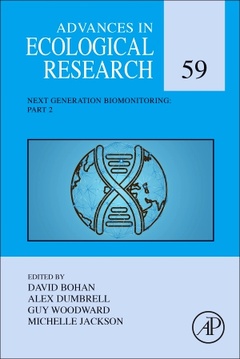Description
Next Generation Biomonitoring: Part 2
Directors of collection: Bohan David, Dumbrell Alex, Woodward Guy, Jackson Michelle
Language: English
Subjects for Next Generation Biomonitoring: Part 2:
Keywords
Ecological Biomonitoring; Biodiversity; Microbiology; Metabolomics
298 p. · 15x22.8 cm · Hardback
Description
/li>Contents
/li>Readership
/li>Biography
/li>Comment
/li>
Next Generation Biomonitoring: Part Two, Volume 59, the latest release in the Advances in Ecological Research series, is the second part of a thematic on ecological biomonitoring. It includes specific chapters that cover aquatic volatile metabolomics using trace gases to examine ecological processes, next generation approaches to rapid monitoring Bio-aerosol and the link between human health and environmental microbiology, NGB in Canadian wetlands, CELLDEX/global monitoring of functional responses, Citizen Science and Biomonitoring, and more.
1. Aquatic volatile metabolomics – using trace gases to examine ecological processes Michael Steinke 2. Next generation approaches to rapid monitoring Bio-aerosol and the link between human health and environmental microbiology Robert Michael William Ferguson 3. NGB in Canadian wetlands Donald Baird 4. Monitoring the biodiversity and functioning of terrestrial systems via high resolution trace gas fluxes Kelly Robert Redeker 5. Computational approaches to gathering biomonitoring data from social media platforms: a superior solution to next generation biomonitoring challenges? Jon Chamberlain 6. What more can the eDNA-NGS revolution bring to biomonitoring? - the untapped potential of molecular methods Alex J. Dumbrell 7. Bioinformatics for Biomonitoring: Species Detection and Diversity Estimates across Platforms and Tools Joanne E. Littlefair 8. Derocles et al. Statistics from networks or other Biomonitoring – what are the statistics of measuring and evaluating change? Athen Ma 9. CELLDEX/global monitoring of functional responses Scott Tiegs 10. Citizen Science and Biomonitoring Michael Pocock
Dave has most recently begun to work with networks. He developed, with colleagues, a learning methodology to build networks from sample date. This has produced the largest, replicated network in agriculture. One of his particular interests is how behaviours and dynamics at the species level, as studied using the carabid-slug-weed system, build across species and their interactions to the dynamics of networks at the ecosystem level.
Dr Alex Dumbrell works at the School of Biological Sciences, University of Essex, UK.
Guy Woodward is Professor of Ecology in the Department of Life Sciences at Imperial College London and Series Editor for Advances in Ecological Research. He has authored over 100 peer-reviewed publications, including recent papers in Nature, Science and Nature Climate Change, with a strong emphasis on understanding and predicting how aquatic ecosystems and food webs respond to a wide range of biotic and abiotic stressors, including climate change, chemical pollution, habitat degradation and invasive species. Much of this work covers multiple scales in space and time and also a range of organisational levels - from ge
- Provides information that relates to a thorough understanding of the field
- Deals with topical and important reviews on the physiology, populations and communities of plants and animals




